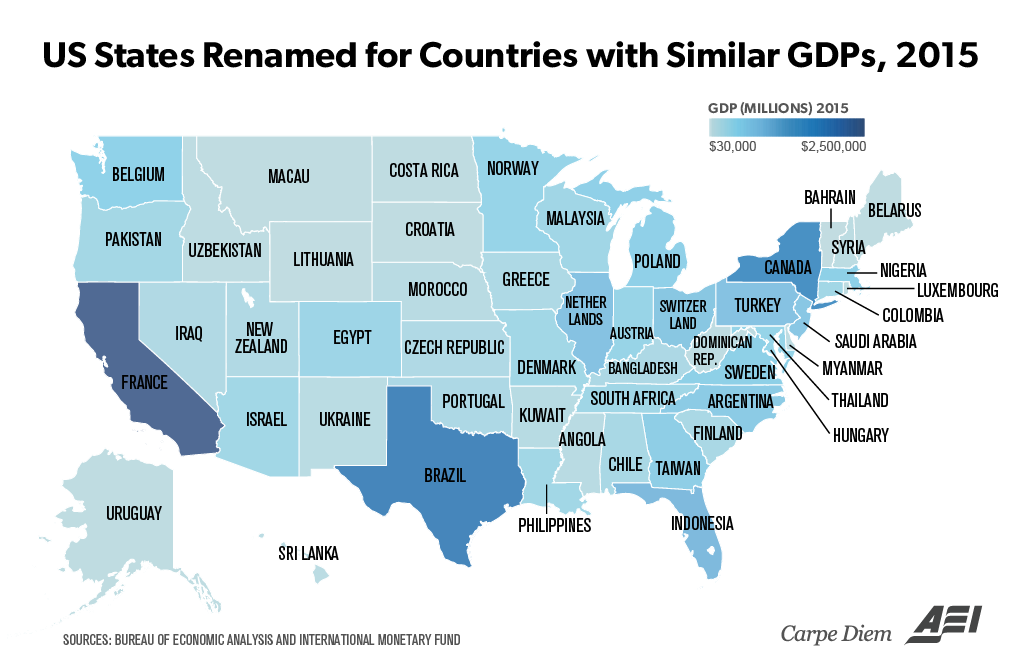
This article first appeared on the American Enterprise Institute site.
The map above was created (with assistance from AEI's graphic design director Olivier Ballou) by matching the economic output (GDP) in each U.S. state (and the District of Columbia) in 2015 to foreign countries with comparable nominal GDP last year, using data from the BEA for GDP by U.S. state and data for GDP by country from the International Monetary Fund.
For each U.S. state (and the District of Columbia), I identified the country closest in economic size in 2015 (measured by nominal GDP), and for each state there was a country with a pretty close match—those countries are displayed in the map above and in the table below. Obviously, in some cases the closest match was a country that produced slightly more, or slightly less, economic output in 2015 than a given U.S. state.
It's pretty amazing how ridiculously large the U.S. economy is, and the map above helps put America's GDP of $18 trillion in 2015 into perspective by comparing the GDP of U.S. states to other country's entire national GDP. For example:
1. America's largest state economy is California, which produced $2.44 trillion of economic output in 2015, just slightly above the GDP of France during the same period of $2.42 trillion.
Consider this: California has a workforce of about 19 million compared to an employment level in France of slightly more than 25 million workers. Amazingly, it required 56 percent (and 9 million) more workers in France to produce the same economic output last year as California! That's a testament to the superior, world-class productivity of the American worker.
Further, California as a separate country would have been the sixth largest economy in the world last year, ahead of France ($2.42 trillion) and India ($2.09 trillion) and not too far behind No. 5 U.K. at $2.85 trillion.
2. America's second largest state economy—Texas—produced $1.64 trillion of economic output in 2015, which would have ranked the Lone Star State as the world's 10th largest economy last year, behind No. 9 Brazil with $1.77 trillion of economic output.
Although Brazil out-produced Texas last year by almost 8 percent, the workforce of Brazil is around 91 million employees compared to payroll employment in Texas of only about 12 million. So to produce just slightly more economic output last year, Brazil's workforce is larger by almost 80 million workers compared to the U.S.!
3. Even with all of its oil wealth, Saudi Arabia's GDP in 2015 at $653 billion was below the GDP of U.S. states like Pennsylvania ($680 billion) and Illinois ($768 billion).
4. America's third largest state economy—New York with a GDP in 2015 of $1.45 trillion—produced nearly the same amount of economic output last year as Canada ($1.55 trillion) and would have ranked as the world's 11th largest economy last year as a separate country, ahead of both South Korea ($1.38 trillion) and Russia ($1.32 trillion).
Amazingly, even though Canada produced about 7 percent more economic output last year than the state of New York, there are almost twice as many Canadian workers (about 18 million) as the number of workers employed in New York (9.2 million). Another example of the world-class productivity of the American workforce.
5. Other comparisons: Florida ($888 billion) produced about the same amount of GDP in 2015 as Indonesia ($858 billion), even though Florida's workforce of 9.3 million is about 8 percent of Indonesia's workforce of 115 million employees. GDP in Illinois last year of $768 billion was just slightly higher than economic output in the Netherlands ($738 billion), even though employment in Illinois (6.2 million workers) is about 25 percent below the employment level in the Netherlands (8.34 million workers).
Overall, the U.S. produced 24.5 percent of world GDP in 2015, with only about 4.5 percent of the world's population. Three of America's states (California, Texas and New York)—as separate countries—would have ranked in the world's top 11 largest economies last year.
Together, those three US states produced $5.5 trillion in economic output last year, and as a separate country would have ranked as the world's third largest economy and ahead of No. 3 Japan ($4.1 trillion) by almost $1.5 trillion.
And one of those states—California—produced more than $2 trillion in economic output in 2015—and the other two (Texas and New York) produced more than $1.6 trillion and $1.4 trillion of GDP in 2015 respectively.
Adjusted for the size of the workforce, there might not be any country in the world that produces as much output per worker as the US, thanks to the world-class productivity of the American workforce.
The map above and the statistics summarized here help remind us of the enormity of the economic powerhouse we live and work in. So let's not lose sight of how ridiculously large and powerful the US economy is, and how much wealth, output and prosperity is being created every day in the largest economic engine ever in human history.

Note: Earl Fry, Professor of Political Science at Brigham Young University, gets credit as the original creator of U.S. maps with states renamed for countries with similar GDPs (international doppelgangers of U.S. states). He has produced these maps on a regular basis since 2003.
Mark J. Perry is a scholar at the American Enterprise Institute and a professor of economics and finance at the University of Michigan's Flint campus.
Uncommon Knowledge
Newsweek is committed to challenging conventional wisdom and finding connections in the search for common ground.
Newsweek is committed to challenging conventional wisdom and finding connections in the search for common ground.
About the writer
To read how Newsweek uses AI as a newsroom tool, Click here.








